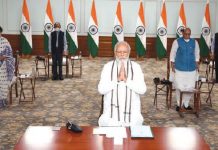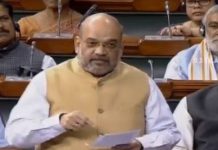At a time when the Central government is supposed to act swiftly, its unperturbed officials are still looking to build a public narrative trying to prove that everything was hunky-dory

The present government has often been criticized for building a positive perception about its performance. However, results of recent elections, the worsening of pandemic, scarcity of everything connected with the health system and inability to find a solution to farmer’s agitation seems to have dented public perception. At a time when the government was supposed to act swiftly, the unperturbed officials are still looking to build a public narrative trying to prove that everything was hunky-dory.
Recently about 300 top officials of the Union Government participated in a workshop titled Effective Communications. Information & Broadcasting minister Prakash Javadekar was present at the workshop, insiders told. The workshop was conducted by Abhishek Singh, the CEO of My Gov. It is a government platform for citizen engagement to create a positive image of the government. The entire exercise was aimed at changing the narrative so that the government looks to be sensitive, bold, quick, responsive, listening to the public and providing them solutions.
Interestingly the workshop for need to change the narrative was held at a time when the Election Commission of India had approached the Supreme Court with a special leave petition against oral observations by the Madras High Court that the Election Commission should be put on murder charge for “not stopping political parties from wanton abuse of the Covid-19 protocol” in election rallies. A Bench of Justices D Y Chandrachud and M R Shah told the Election Commission of India that the observations made by judges while hearing cases are in the “larger public interest”, and the media cannot be stopped from reporting them. The Supreme Court said, “We cannot in today’s times say that the media will not report the discussions that take place in court.”
It is not only post covid scenario, the fact is that the government’s policy has been characterized by a singular motif: changing the script to change the narrative. This rests on its ability to challenge fundamental assumptions as fait accompli. How to change narrative was proved during surgical strike like action being taken by the government viz-a-viz undertaken under previous governments. The difference lies in earlier decisions to keep these actions covert, as opposed to their more recent public confirmations. Publicity helps the cause of signaling a change in script, such as claims of taking bolder risks. This appears to have been precipitated chiefly by the view that the Prime Minister Manmohan Singh-led government did nothing. The divergences in signaling are best encapsulated by the combination of political statements, diplomatic steps, and military choices this government has made in support of its risk-taking approach. For short time, it could work but there is always a need to implement a long-term strategy with a built-in hedging mechanism to address all issues.
For instance even as India fights a deadly pandemic second wave, Central Vista project being built at a cost of about Rs 20,000 crore has been the center of many discussions in the corridors of power. It has been put in the category of “essential service”. When there is a spike in cases, deaths and people dying for oxygen and ventilators, the project is under scanner because special permissions have been given so that work on the project continues unabated. You may call it misplaced priorities or egos. The project includes a new parliament house to replace the current one, new residences for the prime minister and the vice-president, and offices for several central government departments. It would have a new parliament building complex that has the capacity to seat 1,224 members in the upper house and 888 in the lower house. Currently, the upper house accommodates 245 while the lower house has a capacity of 545. The new complex will also have separate offices for all the members of parliament. It will also have the prime minister’s residence with 10 four-storey buildings. The government aims to complete Central Vista by December 2022.
It is generally believed that foreign media is hitting the perception of government very hard. In an article published in the Guardian, it was said that while India is desperate for oxygen, its politicians deny there is a problem. In an opinion piece, the writer says in the Guardian that at a time when the country scrambles to gather oxygen for its Covid-19 patients, many of whom have even died because of its shortage, there are political leaders who not only disregard the crisis but also threaten to take action against people who voice their opinion regarding it.
Attributing election rallies to the surge in Covid cases across the country, an article in CNN said, the responsibility for India’s second wave belonged “first and foremost” to the government and people expect their governments to assure them that they are in charge and taking care of things, but the government is almost missing in action.
An editorial in Atlantic opined that the government did very little in the time it got between the first and second wave to help avert the current crisis. “After the virus landed on India’s shores, a brutal shutdown was imposed that largely hurt the poorest and most vulnerable. The lockdown was imposed allegedly without consulting the nation’s top scientists. Again, yet did not use the time to build up the country’s health-care infrastructure and the government offered an air of triumphalism.
The Financial Times, in an article titled “The tragedy of India’s second wave”, warned that “With reports of people dying in the streets outside overwhelmed hospitals running short of oxygen, India today perhaps most closely resembles the worst-case scenarios painted when the virus was identified 16 months ago. The French newspaper Le Monde alleged, “lack of foresight, arrogance, and demagoguery are evidently among the causes of a situation that now seems out of control”.
The Time Magazine, in an opinion piece, has called out the Indian media over “exaggerating the government’s successes”, saying that it is this “lack of accountability” that led to the current crisis. It said that “Many Hindi- and English-language news channels, as well as regional news outlets, unabashedly exaggerated the government’s successes and either glossed over its failures or spun ways to pin down the opposition, liberals, Muslims, activists, leftists, protesters, NGOs, and others as anti-nationals.”
Concerned by the criticism at a time when there is a shortage of beds and oxygen and increasing fatalities, the workshop held through a video-conference with senior government officials shows that the government is seriously attempting to change the narrative to change perception from negative to positive. A case in instance is government displeasure over the reports about the crash of CoWin portal during vaccination registration for 18 plus category. Indeed, since the beginning of the second Covid wave, the government has received flak for its “mismanagement” of the pandemic, including allowing the Kumbh mela and election rallies etc. The government’s attempts to build a narrative are aimed at diffusing all this.
tehelkaletters@gmail.com












